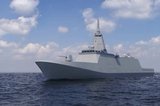RAM Block 2 completes first phase developmental testing
Raytheon has announced that its Rolling Airframe Missile Block 2 has completed the first series of developmental and operational testing (DT/OT) by the US Navy.
The tests saw the RAM Block 2 missiles successfully engage two targets in tactical dual-salvo scenarios designed to demonstrate the advanced missile's defensive capabilities, with all four RAM Block 2 missiles meeting test objectives. The at-sea DT/OT testing was conducted from the US Navy's Self-Defense Test Ship.
The testing is part of the work being carried out to fulfil the low-rate production contract awarded to Raytheon and its manufacturing partner, RAMSYS, in December 2012 for the production of 61 US Navy RAM Block 2 missiles. The company also received $155.6 million Block 2 production contract for the German navy earlier this year.
Rick Nelson, vice president of Raytheon Missile Systems' Naval and Area Mission Defense product line, said: ‘RAM Block 2's success in these developmental tests follows the completion of a series of guidance test vehicle flight tests. RAM Block 2's increased kinematic capability and its advanced guidance system will continue to give the warfighter an unfair advantage in the fight.’
The RAM Block 2 upgrade includes a four-axis independent control actuator system and an increase in rocket motor capability, increasing the missile's effective range and delivering a significant increase in manoeuvrability. The improved missile also incorporates an upgraded passive radio frequency seeker, a digital autopilot and engineering changes in selected infrared seeker components.
RAM is a supersonic, lightweight, quick reaction, fire-and-forget missile providing defence against anti-ship cruise missiles, helicopter and airborne threats, and hostile surface craft. The missile's autonomous dual-mode, passive radio frequency and infrared guidance design provide a high-firepower capability for engaging multiple threats simultaneously.
More from Naval Warfare
-
![NATO tests use of “undetectable, jam-proof” laser communication in maritime scenarios]()
NATO tests use of “undetectable, jam-proof” laser communication in maritime scenarios
As part of its effort to better prepare its capabilities for operations in contested and congested scenarios, NATO evaluated a Lithuanian ship-to-ship terminal designed to not be susceptible to enemy interference.
-
![Future of the Canadian Patrol Submarine Project is still unclear]()
Future of the Canadian Patrol Submarine Project is still unclear
The Canadian government remains tight-lipped on the timeline and funding required for the next steps of its Canadian Submarine Patrol Project, which should offer improved capabilities for the country’s navy.
-
![Mitsubishi eyes future with Australia’s Mogami selection]()
Mitsubishi eyes future with Australia’s Mogami selection
With Australia’s selection of the Mogami-class for Project Sea 3000, Mitsubishi is investigating local production in the next decade as potential export opportunities emerge.
-
![Thales’ new Sonar 76Nano could equip UK Royal Navy on anti-submarine warfare missions]()
Thales’ new Sonar 76Nano could equip UK Royal Navy on anti-submarine warfare missions
The new sonar is designed to equip uncrewed underwater vessels, with the potential to be used by the Royal Navy for its Atlantic Bastion and Atlantic Net missions.























